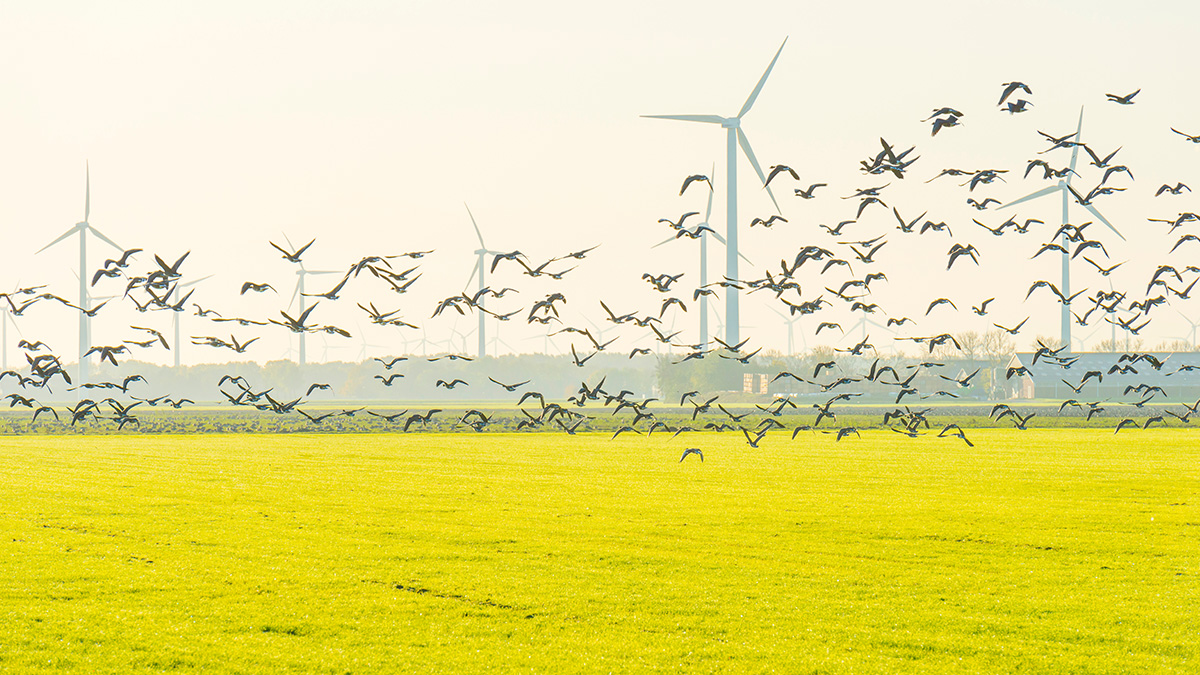8 June 2022
The energy transition goes together with nature protection

The European Commission’s REPowerEU Action Plan of 18 May 2022 set out detailed measures to reduce Europe’s dependence on Russian fossil fuels and accelerate the growth of renewables. Crucially it tackles the permitting bottlenecks that are holding back the expansion of wind and solar. But simpler and faster rules and procedures to build wind farms doesn’t mean levelling down on nature and biodiversity protection. Both are essential. They go hand in hand.
Faster renewables-based decarbonisation is key for both climate neutrality and energy security. Europe imports 58% of its energy from elsewhere – mostly fossil fuels and often from countries posing geopolitical risks. So we need more wind and solar, and we need them faster. The European Union wants wind energy to be 50% of its electricity by 2050. By 2030, they want 510 GW of wind – up from 190 GW today.
The EU is only building half of the new wind farms it needs to meet this target. The main problem is the slow and complex permitting of new projects. The Commission’s REPowerEU Action Plan aims to solve this issue with new legislative proposal, recommendations and guidance for Member States. They propose, among other things, to enshrine in EU law the principle of “overriding public interest” for renewables. This means Member States should treat renewables projects as serving public health and safety, and their build-out can be prioritised in the current energy crisis where they do not have significant adverse effects on the environment which cannot be mitigated or compensated.
Simpler and faster permitting of wind projects is good news for the environment. Wind is a clean, renewable and locally available energy source. Wind energy’s water footprint is almost zero. And operating wind turbines don’t emit greenhouse gases like carbon dioxide (CO2) or any other air pollutants such as SOx, NOx or PM. The CO2 emissions associated with the construction, transport, operation and dismantling of wind turbines are paid back in less than a year of operation. More wind in our energy system gives us a greater chance to mitigate the potentially disastrous impacts of climate change on nature and biodiversity.
But how do wind farms affect the natural environment? As with many human activities, wind farms can impact on local habitats, fauna and flora. The wind industry makes huge efforts to monitor and reduce these impacts. Wind farm developers follow a clear hierarchy of measures: impacts are avoided where possible, reduced, mitigated, and compensated.
The first and most crucial step is the siting and design of wind farms. Appropriate siting and design greatly reduces the extent and severity of impacts. Before construction all projects are assessed by a rigorously independent planning and approval process. Developers carry thorough Environmental Impact Assessments to identify all potential impacts of their projects, and continue to monitor these impacts during operation.
The construction itself can cause disruptions to wildlife, but these are temporary. And the wind industry has means to reduce them. Offshore wind developers for example can use “air bubble curtains” and hydro-tampers to limit sound emissions generated form piling, which helps mitigate the disturbances to sea animals.
Once installed, wind farm sites are left undisturbed for many years. In offshore wind farms bottom trawling and dredging cannot take place. This helps preserve the seabed which can restore in these conditions. And wind turbine foundations act as artificial reefs for marine wildlife: each wind turbine can support up to 4 metric tons of shellfish that attract other species such as fish and larger sea mammals. Wind project developers also take extra measures, where it’s needed, to protect biodiversity. They use technology to detect, deter and decoy birds and bats; and in some cases even stop the turbines from spinning at certain times.
Wind farms can also bring net gains for their local environment, and support biodiversity restoration. Onshore wind farms can be managed to serve as safe havens for bees and other pollinators. Offshore wind farms can help restore local marine life, such as the European flat oyster in The Netherlands.
In fact the deployment of wind energy we need to meet our climate objectives and enhance our energy security goes hand in hand with nature protection. Both are mutually beneficial. It’s therefore important to have a good working balance between these parallel sets of public policy interest. The wind industry is committed as ever to protect biodiversity and engage with civil society, public authorities and the scientific community to that end. We work for example with environmental NGOs and transmission system operators in the Offshore Coalition for Energy and Nature (OCEaN) to help the EU and national governments reach their climate and energy goals while ensuring the success of their environmental protection and biodiversity strategies.
Visit our website to learn more about wind energy and the environment and see our latest infographic on the actions we’re taking to preserve biodiversity.

